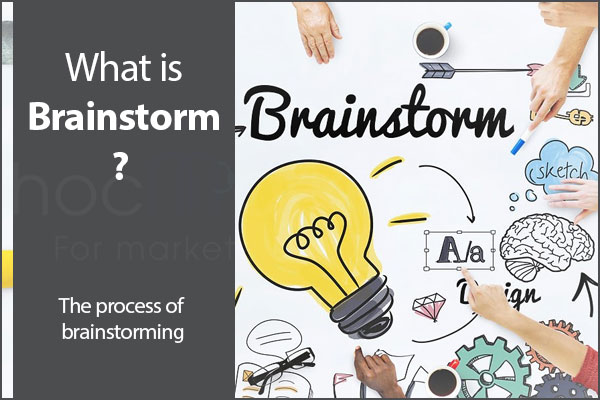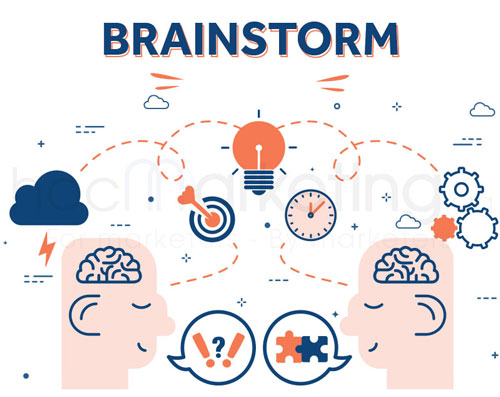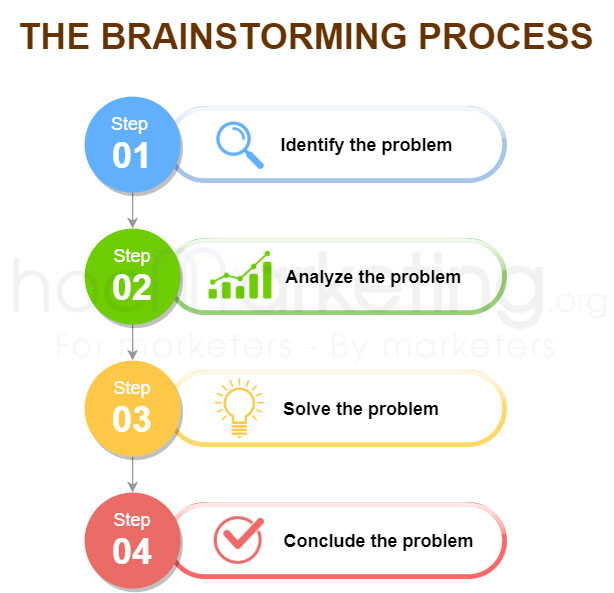
What is brainstorm? The process of brainstorming

What is Brainstorm? Analyze the concept and role (application) of brainstorming. Guide to brainstorming steps. Some things to keep in mind during brainstorming.
What is brainstorm?
Brainstorm is an English term that refers to the advanced activities of the brain such as thinking, analyzing, creating, comparing, reasoning...
Brainstormer is a person who participates in the process of brainstorming.
The term "BRAINSTORM" was first used by one of the most famous figures in the marketing world, Alex Faickney Osborn, in a book on advertising he wrote published in 1948. In particular, Osborn had to confront Faced with running out of ideas for an advertising campaign. And then, he mobilized all employees into the meeting room to focus on "producing" ideas. That meeting unfolded like a storm, and that was the inspiration for the birth of the phrase "brainstorm".
Brainstorming uses
Brainstorm acts as a "headquarter" for the development of human society. This development is present in almost every aspect of society, from health, education, science, technology, finance, business... to politics, law, institutions...
Human history has witnessed many inventions that have changed the human world, such as the introduction of the electric light bulb (Edison), the telephone (Alexander Graham Bell), the Internet (Tim Berners-Lee), the computer. (Charles Babbage), United Nations, World Health Organization, Communism... These inventions all originate from human brainstorming activities.
Today, brainstorming is widely used in creative-related activities such as:
- Marketing: Developing ideas and themes for promotional programs, communication...
- Content: Build ideas, scripts for content products (articles, videos...)
- Technology: New ideas for tools, equipment, machines, software...
- Administration: Human resource, financial, risk management solutions...
Major types of brainstorming
Individual brainstorming: Only one individual participates from the beginning to the end of the brainstorming process.
Organizational brainstorm : Many individuals (in a team, group, department, company...) participate in the brainstorming process.
The brainstorming process
In general, the brainstorming process will go through 4 steps (stages)
Step 1. Identify the problem
Certainly, you cannot brainstorm without any goal or direction. The first step always in a brainstorming process is to identify the problem you are trying to solve. Such as:
- You are looking for a new business video advertising idea.
- You are looking to build a design concept for a new product.
- You are writing a script for a new movie.
- Are you looking for an idea for a new game?
- You are looking for a solution to manage your staff that is more effective than the previous year.
- You are looking for a solution to improve your income in the new year.
- You're building a format for an upcoming group presentation...
In general, problems when posed (identified) in a specific way will help the brainstorming process become effective and fast. On the contrary, if the problem is posed in a vague, ambiguous, unclear way... the brainstorming process will become ineffective, protracted or even unending.
Step 2. Analyze the problem
Based on the identified problem, the person participating in the brainstorming process (brainstomer) will begin to analyze the aspects closely related to the problem. Depending on the field, time, and circumstances, the brainstormer can analyze in different aspects.
Suppose, at a meeting of a media company, there is a problem that needs to be solved by the meeting participants: "an idea for a new corporate clip". In this case, the brainstormer can consider aspects including: Characteristics of the target audience (customers) that the advertisement clip is aiming at, the characteristics of the products/services in the promotional clip, duration, budget, market trends...
Step 3. Solve the problem
When the initial hypothesis is put forward, it marks the beginning of the problem-solving process. During this process, there may be one or more different hypotheses put forward, and the brainstormer needs to perform many stages such as comparing, contrasting, evaluating... to be able to choose the most suitable hypothesis. . This process can be called a struggle, because during the process will generate a lot of contradictions, manifesting in many forms, from thinking contradictions (comparing the pros and cons of hypotheses), emotional contradictions, etc. emotions (reason tells you to choose hypothesis A, but emotions make you want to choose hypothesis B), internal conflicts when working in groups (participants defend their hypothesis) and negating the hypothesis of others)... Usually, the outcome of this struggle (conflict resolution) process will be a hypothesis that best solves the problem in a particular context.
Going back to the example in step 2, the brainstormers briefly came up with different ideas and began to criticize each other to choose the most suitable idea for the upcoming promotional clip.
Step 4. Conclude the problem
The hypothesis that can best solve the problem will be drawn into a conclusion that can be applied to solve another problem.
Things to keep in mind during brainstorming
1. Always keep your mind in a calm, lucid and lucid state
When the reptilian brain layer and the human brain layer are very active (or it can be said that when your psyche is covered with fear, or strong emotions), the human brain layer will tend to be active. Weak action (slow problem solving, easy to make wrong decisions...). Therefore, keeping the mind in a calm, lucid and lucid state is always an important factor to help the brainstorming process achieve high efficiency.
2. Don't be afraid to argue
As analyzed in step 3 of the brainstorming process, group brainstorming always has controversy, because it comes from a struggle. There is a struggle to get results, so instead of avoiding it, accept it as an inevitable problem.
3. Always analyze problems in two opposite directions
Looking at a problem only in one direction will lead to a state of being guessing, conservative, and one-sided, thereby reducing the effectiveness of the whole brainstorming process. Therefore, when discussing and analyzing a certain problem, in addition to the opinion that you think is right, try to think in the opposite direction to get thoroughness in the hypothesis you are about to give.
4. Pay attention to communication language
Although we know that communication is a tool for expressing our opinions, sometimes we can't control the words that come out of our mouths, and unfortunately, one of them makes a or many people involved in the brainstorming process feel hopeless, depressed, or even hurt.

















